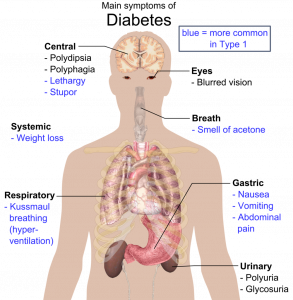 Your group is working on a big project for class, and the deadline is quickly approaching. The clock strikes 3pm and you realize you have not eaten. None of your peers have taken a lunch break, and they seem to be OK (aside from the loud, grumbling noises erupting from their stomachs). You begin to feel dizzy. The moment you stand from your cozy swivel chair, black spots trail across your vision. You fall back down into your chair with a loud crash. Embarrassed, you ask a group member to grab a Gatorade from the vending machine.
Your group is working on a big project for class, and the deadline is quickly approaching. The clock strikes 3pm and you realize you have not eaten. None of your peers have taken a lunch break, and they seem to be OK (aside from the loud, grumbling noises erupting from their stomachs). You begin to feel dizzy. The moment you stand from your cozy swivel chair, black spots trail across your vision. You fall back down into your chair with a loud crash. Embarrassed, you ask a group member to grab a Gatorade from the vending machine.
Life with Diabetes
For a diabetic, a missed or delayed meal can send blood sugar diving, leading to a number of dangers. Livestrong warns, “Low blood sugar, or hypoglycemia, can be a potentially dangerous health event for diabetics. You may develop headaches, dizziness, sweating and fatigue due to the low level of glucose in your blood. Your cognitive function and memory may also be impaired. Some of the more drastic effects of hypoglycemia include seizures, an irregular heartbeat and difficulty with speech” (Morgan). Diabetics must take extra care in keeping their blood sugar in check to avoid these symptoms.
What is Type 1 Diabetes?
You must understand that there are two types of diabetes, which stem from different causes. Thus, these two diseases must be treated differently. The American Diabetes Association (ADA) states, “Type 1 diabetes is usually diagnosed in children and young adults . . . Only 5% of people with diabetes have this form of the disease. In type 1 diabetes, the body does not produce insulin. Insulin is a hormone that is needed to convert sugar, starches and other food into energy needed for daily life” (ADA). Type 1 diabetics must take daily doses of insulin to help their bodies create and maintain energy.
What about Type 2?
WebMD declares, “Unlike people with Type 1 diabetes, the bodies of people with Type 2 diabetes make insulin. However, either their pancreas does not make enough insulin or the body cannot use the insulin well enough . . . When there isn’t enough insulin or the insulin is not used as it should be, glucose (sugar) can’t get into the body’s cells. When glucose builds up in the blood instead of going into cells, the body’s cells are not able to function properly” (WebMD). While Type 2 diabetics do have insulin in their system, their bodies have difficulty utilizing it.
Know the Distinction
Because of the differences between the two types of diabetes, there is separate advice regarding exercise.
Exercising: Type 2 Style
The recommendation for Type 2 diabetes is simple, so let’s start here. The Mayo Clinic informs, “Type 2 diabetes develops when the body becomes resistant to insulin or when the pancreas stops producing enough insulin. Exactly why this happens is unknown, although excess weight and inactivity seem to be contributing factors” (Mayo). Therefore, exercise is regarded as safe, and is “highly recommended” for those with Type 2 diabetes. The only exception is if you are treated with insulin, in which case exercise can lead to hypoglycemia (keep reading to find out what this means).
Practice Makes Perfect
Health Magazine reassures, “If you’re like many newly diagnosed Type 2 diabetics, you may not have exercised in years. If that’s the case, don’t worry: It’s fine to start slow and work up. These tips will help you ease back into exercise and find a workout plan that works for you” (Health). Don’t stress about starting a routine; it’s easier than it sounds!
But, I Have a Mental Block Against Working Out
If you hate the words “gym, working out, and exercise,” don’t use them. Don’t think of it as working out. Anything you can do to get your body moving is highly beneficial. Your life isn’t an episode of MTV’s controversial Jersey Shore (thankfully), and you don’t have to spend hours in the gym. Even if you are just cleaning around the house, playing in the ocean waves, or busting a move to your favorite radio station, getting your body in motion is crucial for your health.
Exercising With Type 1 Diabetes
It is crucial to know that physical activity paired with Type 1 diabetes is not an equally simple scenario. Exercise can be potentially dangerous for these patients.
Hyperglycemia
Physical exertion and exercise can actually raise blood glucose (hyperglycemia) in those with type 1 diabetes. Hyperglycemia can happen when diabetics eat too much sugar, when they are low on insulin, or when they become stressed. How, then, can hyperglycemia stem from something normally considered healthy: exercise?
The ADA reveals, “Blood glucose can also run high during or after exercise, particularly when you do a high-intensity exercise that increases your stress hormone (glucose-raising hormone) levels” (ADA). The more strenuous of an activity, the more stress hormones it produces. The higher the levels of stress hormones, the more likely Type 1 diabetics will face hyperglycemia.
Hypoglycemia
Working out can also cause low blood pressure (hypoglycemia) in diabetics. The ADA states, “Everyone with diabetes should be prepared to treat hypoglycemia, but people with type 1 are at the highest risk for hypoglycemia. People with type 2 are less likely to have issues with hypoglycemia during or after exercise, unless they are on insulin or an insulin secretagogue” (ADA). They continue by revealing that hypoglycemia is more likely if you have skipped a meal, if you exercise for too long, or if you exercise too strenuously.
Keep Tabs
Overall, diabetics should check their blood sugar before they work out. The Mayo Clinic warns that you should stop exercising if “your blood sugar is 70 mg/dL or lower, or if you feel shaky, weak or confused.” They also suggest that you “eat or drink something to raise your blood sugar level, such as: Three or four glucose tablets, 1/2 cup of fruit juice, 1/2 cup of regular (not diet) soda, [or] Five or six pieces of hard candy” (Mayo). Feeling shaky and weak can be a sign of hypoglycemia, so treat it with a bit of sugar!
Diabetes Diagnosis
Learn the early warning signs and the symptoms associated with diabetes. The ADA notes that those with Type 2 diabetes might not notice their symptoms, as they are very mild. If you do, however, notice these symptoms, always see a doctor!
Florida National University: We Care for Our Students
We want to ensure our students are the happiest and healthiest they can be. Review our safety manual if you have any concerns regarding health or safety. We also provide links to health insurance for students. If you are interested in any of Florida National University’s other programs, apply now!
Sources
“15 Exercise Tips for People With Type 2 Diabetes.” Health.com. Health Magazine, n.d. Web. 01 May 2014.
“Causes.” Type 2 Diabetes Causes. Mayo Clinic, n.d. Web. 01 May 2014.
“Diabetes and Exercise.” Diabetes. Mayo Clinic, 22 Feb. 2014. Web. 01 May 2014.
“Exercise and Type 1 Diabetes.” American Diabetes Association. American Diabetes Association, 10 Apr. 2014. Web. 01 May 2014.
“Hypoglycemia (Low Blood Glucose).” American Diabetes Association. American Diabetes Association, 20 Mar. 2014. Web. 30 Apr. 2014.
Morgan, Rachel. “The Effects of Skipping Meals With Diabetes.” LIVESTRONG.COM. LIVESTRONG, 26 Feb. 2014. Web. 01 May 2014.
“Type 1 Diabetes – American Diabetes Association®.” American Diabetes Association. American Diabetes Association, n.d. Web. 1 May 2014.
“Type 2 Diabetes: Symptoms, Causes, Treatments, and More.” WebMD. WebMD, n.d. Web. 30 Apr. 2014.



